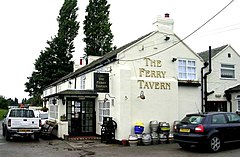Penketh
| Penketh | |
|---|---|
 The Ferry Tavern public house, Penketh |
|
| Penketh shown within Cheshire | |
| Population | 8,699 (2001) |
| OS grid reference | SJ595891 |
| Civil parish |
|
| Unitary authority | |
| Ceremonial county | |
| Region | |
| Country | England |
| Sovereign state | United Kingdom |
| Post town | Warrington |
| Postcode district | WA5 |
| Dialling code | 01925 |
| Police | Cheshire |
| Fire | Cheshire |
| Ambulance | North West |
| EU Parliament | North West England |
| UK Parliament | |
Penketh is a civil parish and suburb of Warrington, Cheshire, England. It is located about 3 miles (4.8 km) west of Warrington town centre. It has a population of 8,699.
The name is derived from two Brythonic words: *penno- (head) and *kēto- (trees) (Welsh pen coed); suggesting that the parish, at one time was on the outskirts of a forest. The emblem/badge of Penketh is three kingfishers.
Penketh was originally part of Prescot parish but became a chapelry and then a separate parish. It grew due to the crossing over the Mersey at Fiddlers Ferry and the building of the Sankey Canal. The area was mainly rural and agricultural until well into the 20th century, though a tannery and boatyard were established in the 19th century.
The last 50 years has seen the area transformed into a large residential suburb.
Historically within Lancashire, the parish has a Parish Council and is a ward of Warrington Borough. It is in Warrington South constituency of the United Kingdom Parliament. Until the major local government reorganisation of 1974, Penketh was part of Warrington Rural District.
The former tannery and boatyard were the only major industries in Penketh. Fiddlers Ferry Power Station dominates Penketh, though it is in Cuerdley parish.
There is a parish church (St Paul's, Church of England), and a Catholic church (St Joseph's). There is a strong nonconformist tradition as exemplified by the Methodist chapel in Chapel Road. The Quakers were well represented at one time; the Meeting House was the present village hall on Meeting Lane.
...
Wikipedia

